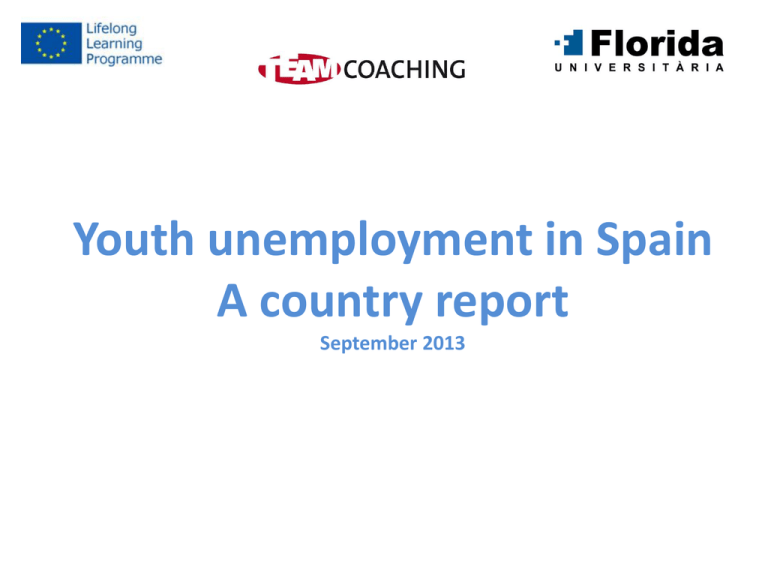PowerPoint-Präsentation
advertisement

Youth unemployment in Spain A country report September 2013 INDEX 1. The economic situation in Spain and the youth unemployment 2. National System of Employment 3. Educational System 1. The Economic Situation in Spain and the youth unemployment Before 2008 From 2003 to 2007 the GNP (Gross National Product) grew up more than 3% per year. Two sectors were the most important: the financial and the building sectors Between 2004 and 2008 were built more than 3 million houses-flats. (Population: 40 mill.) A lot of students, from secondary school to university, dropped out from their studies to earn money working for building business. Current Situation Nowadays Spain is living the biggest crisis in the last 50 years: More than 6.200.000 people are unemployed. (27,16%) The Gross National Product is going down Spanish state is paying a high interest for its debt Spanish unemployment a) Spanish unemployment Youth Unemployment rate Youth unemployment in Spain has reached a new high of 56.1%, that is a quarter of the 3.5 million under-25s jobless across the Eurozone. 883,000 people. (30th of August 2013) More than five in ten of those young people belong to that new “lost Generation”. A lot of them are moving to other European or Latin American countries looking for a job. Most of them have not graduated because they dropped out from the secondary school or university when they were teenagers. Youth Unemployment rate Youth unemployment rates in Spain http://www.sepe.es/contenido/estadisticas/datos_avance/graficos/paro.html 9 Unemployment Evolution Rates in Valencian Community 10 2. Spanish’s National System of Employment 11 Division of responsabilities: Spain and its Autonomous regions 12 Division of responsabilities The central government sets the general strategies to follow in the "Spanish Employment Strategy “ and more concretely in its “Annual Plan of Employment policies ". Each autonomous region is responsible for managing active labour market policies (programs and services aimed at the direct care of the job seekers). In this collaborative framework between the central government and communities, Autonomous regions may choose to perform employment measures according to state regulations, the region itself or a combination of both. The Ministry of Education is responsible for the general framework of education policies and each autonomous region has the power to set them. 13 Division of responsabilities Transferred Subjects • • • • Vocational Training Labour intermediation Labour guidance Employment Programmes • Execution, recording and reporting of contracts 16 Coordination tools between the Central Government and the Autonomous Regions Law 56/2003, of 16 December, of Employment, establishes coordination instruments within the National Employment System: The Spanish Employment Strategy. The Annual Plan for Employment Policy. The Information System of Public Employment Services. (SISPE-Modernization of Management Improved measuring registered unemployment) 17 Active labour market programs in Valencia Region Integrated Employment Programs for people over 45, under 30 and long-term unemployed Employment Agency (Agencias de Colocación). Training for unemployed 19 3. Educational System in Spain Educational System in Spain https://vocationaleducation.wikispaces.com/School+system+in+Spain 21 22 Educational System in Spain PRE-SCHOOL EDUCATION: 1st cycle: 0-3 years 2nd cycle: 3-6 years (free) COMPULSORY EDUCATION: (free) Primary Education: 6-12 years(free) Secondary Education: 12-16 years (free) POST COMPULSORY EDUCATION: (free) Baccalaureate: 16-18 years (free) Vocational training: 16-18/18-20 years (free) University (fees depending on the degree) https://vocationaleducation.wikispaces.com/School+system+in+Spain 23 Educational Dual System Implantation Spain is trying to establish the German model of „dual system education“. Florida is one of the few educational centers where the pilot experience is going to start. 24 Summary 25 Risks for youth Brain drain (Fuga de cerebros) Generation „ni-ni“ . They don‘t want to study, they don‘t want to work. No free resources available to improve employability: employment programs, employment training Long-term unemployment Return to country of origin (Immigrant people or immigant’s children) 26 Some important points for the future We must train the new generation for the “new world” Train and develop students promoting “added value” jobs Review and prepare effective cooperation between Universities and Businesses 27 Thank you for your attention Sources • Ministerio de Educación, Cultura y Deporte [06/09/2013] http://www.educacion.gob.es/exterior/centros/cervantes/es/ofertaeducativa/estructurasist emedu/estructurasistemaeductivoesp.shtml • Enforced Vocational Orientation Project [06/09/2013] https://vocationaleducation.wikispaces.com/School+system+in+Spain • Sepe http://www.sepe.es/contenido/estadisticas/datos_avance/graficos/paro.html http://www.sepe.es/contenido/conocenos/medios/Dossier_informativo.pdf • Revista de Formación y Empleo „Formación XXI“ http://formacionxxi.com/porqualMagazine/do/get/magazineArticle/2013/02/text/xml/UGT _ante_la_formacion_profesional_dual.xml.html 29











